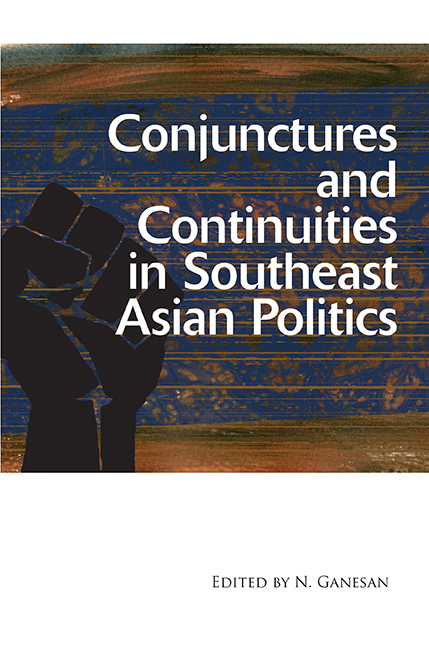Book contents
- Frontmatter
- Contents
- Acknowledgements
- List of Abbreviations
- Contributors
- 1 Conjunctures and Continuities in Southeast Asian Politics
- 2 (Re)Assessing the EDSA “People Power” (1986) as a Critical Conjuncture
- 3 The Road to Doi Moi in 1986: Domestic Dimensions
- 4 The 1988 Uprising in Myanmar: Historical Conjuncture or Praetorian Redux?
- 5 Cambodia's Historical Conjunctures and their Significance
- 6 Changing the Rules: Historical Conjuncture and Transition in Indonesia
- 7 The Resistible Rise of Thaksin Shinawatra: Crisis, Change and the Collapse of Thailand's Democracy
- 8 The March 2008 General Election in Malaysia as a Historical Conjuncture
- 9 Conclusion: Conjunctures and Continuities in Southeast Asia
- Index
4 - The 1988 Uprising in Myanmar: Historical Conjuncture or Praetorian Redux?
Published online by Cambridge University Press: 21 October 2015
- Frontmatter
- Contents
- Acknowledgements
- List of Abbreviations
- Contributors
- 1 Conjunctures and Continuities in Southeast Asian Politics
- 2 (Re)Assessing the EDSA “People Power” (1986) as a Critical Conjuncture
- 3 The Road to Doi Moi in 1986: Domestic Dimensions
- 4 The 1988 Uprising in Myanmar: Historical Conjuncture or Praetorian Redux?
- 5 Cambodia's Historical Conjunctures and their Significance
- 6 Changing the Rules: Historical Conjuncture and Transition in Indonesia
- 7 The Resistible Rise of Thaksin Shinawatra: Crisis, Change and the Collapse of Thailand's Democracy
- 8 The March 2008 General Election in Malaysia as a Historical Conjuncture
- 9 Conclusion: Conjunctures and Continuities in Southeast Asia
- Index
Summary
The 1988 popular uprising that ended the Socialist era of political governance and state building in Myanmar had all the makings of a significant historical conjuncture that not only transformed the country's political and economic systems as well as the nature of ethnic insurgencies but also brought Myanmar's contentious domestic issues to the attention of the international community. It coincided with the emergence of the triumphant outlook of Western democracies capitalizing on the apparent democratic turn following the collapse of Leninist regimes in Europe and brought about the internationalization of Myanmar's security, political and economic issues, premised upon liberal norms of human rights and democracy. The resulting polarized discourse on the country's political and economic reform agenda became part of the contested legacy of the aborted “Four Eights Movement” representing the crest of the revolutionary tide seen by the counter elites as a harbinger of a new political order. However, the democratic aspirations were not realized and the movement's momentum was quickly dissipated as the Tatmadaw (literally meaning royal force), or Myanmar armed forces, re-emerged as the principal steward of Myanmar's destiny. Differing interpretations of that legacy by the military regime and its domestic and foreign detractors have led to divergent attempts of reproduction that have yet to be resolved. On the other hand, a more paranoid, autocratic and powerful regime than the deposed BSPP (Burma Socialist Programme Party) regime emerged in the aftermath of the 1988 uprising, premised on the perpetuation of the Tatmadaw control over political and economic spaces. However, the new constitutional order that took some two decades to become institutionalized through the 2008 Constitution has given some hope for an irreversible change in the political system. This chapter will attempt to identify antecedent conditions preceding the conjuncture and trace the bankruptcy of the BSPP state leading to the rupture in 1988.
- Type
- Chapter
- Information
- Conjunctures and Continuities in Southeast Asian Politics , pp. 67 - 102Publisher: ISEAS–Yusof Ishak InstitutePrint publication year: 2013



